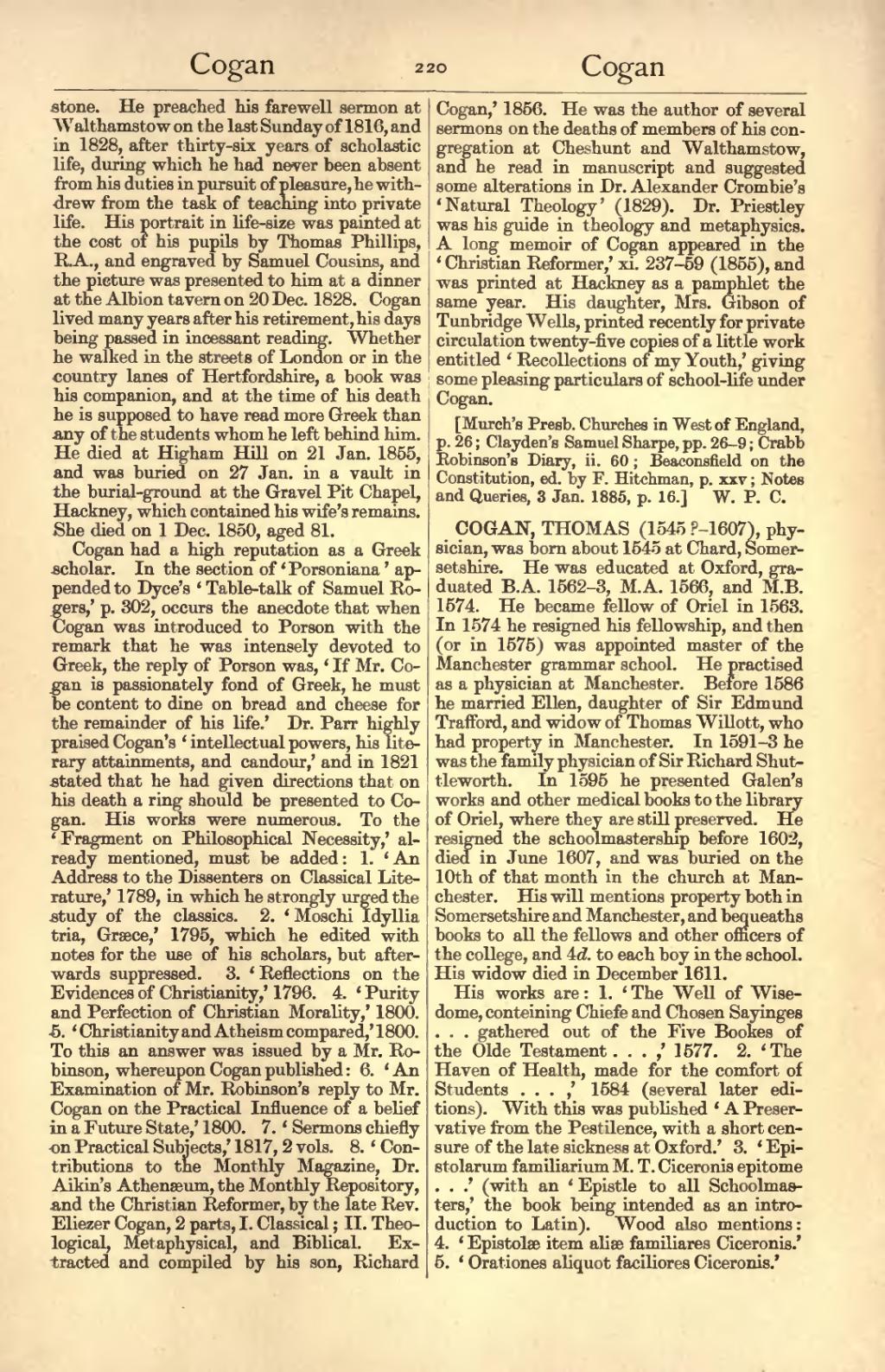stone. He preached his farewell sermon at Walthamstow on the last Sunday of 1816, and in 1828, after thirty-six years of scholastic life, during which he had never been absent from his duties in pursuit of pleasure, he withdrew from the task of teaching into private life. His portrait in life-size was painted at the cost of his pupils by Thomas Phillips, R.A., and engraved by Samuel Cousins, and the picture was presented to him at a dinner at the Albion tavern on 20 Dec. 1828. Cogan lived many years after his retirement, his days being passed in incessant reading. Whether he walked in the streets of London or in the country lanes of Hertfordshire, a book was his companion, and at the time of his death he is supposed to have read more Greek than any of the students whom he left behind him. He died at Higham Hill on 21 Jan. 1855, and was buried on 27 Jan. in a vault in the burial-ground at the Gravel Pit Chapel, Hackney, which contained his wife's remains. She died on 1 Dec. 1850, aged 81.
Cogan had a high reputation as a Greek scholar. In the section of 'Porsoniana' appended to Dyce's 'Table-talk of Samuel Rogers,' p. 302, occurs the anecdote that when Cogan was introduced to Porson with the remark that he was intensely devoted to Greek, the reply of Porson was, 'If Mr. Cogan is passionately fond of Greek, he must be content to dine on bread and cheese for the remainder of his life.' Dr. Parr highly praised Cogan's 'intellectual powers, his literary attainments, and candour,' and in 1821 stated that he had given directions that on his death a ring should be presented to Cogan. His works were numerous. To the 'Fragment on Philosophical Necessity,' already mentioned, must be added: 'An Address to the Dissenters on Classical Literature,' 1789, in which he strongly urged the study of the classics. 'Moschi Idyllia tria, Græce,' 1795, which he edited with notes for the use of his scholars, but afterwards suppressed. 'Reflections on the Evidences of Christianity,' 1796. 'Purity and Perfection of Christian Morality,' 1800. 'Christianity and Atheism compared,' 1800. To this an answer was issued by a Mr. Robinson, whereupon Cogan published: 'An Examination of Mr. Robinson's reply to Mr. Cogan on the Practical Influence of a belief in a Future State,' 1800. 'Sermons chiefly on Practical Subjects,' 1817, 2 vols. 'Contributions to the Monthly Magazine, Dr. Aikin's Athenæum, the Monthly Repository, and the Christian Reformer, by the late Rev. Eliezer Cogan, 2 parts, I. Classical; II. Theological, Metaphysical, and Biblical. Extracted and compiled by his son, Richard Cogan,' 1856. He was the author of several sermons on the deaths of members of his congregation at Cheshunt and Walthamstow, and he read in manuscript and suggested some alterations in Dr. Alexander Crombie's 'Natural Theology' (1829). Dr. Priestley was his guide in theology and metaphysics. A long memoir of Cogan appeared in the 'Christian Reformer,' xi. 237–59 (1855), and was printed at Hackney as a pamphlet the same year. His daughter, Mrs. Gibson of Tunbridge Wells, printed recently for private circulation twenty-five copies of a little work entitled 'Recollections of my Youth,' giving some pleasing particulars of school-life under Cogan.
[Murch's Presb. Churches in West of England, p. 26; Clayden's Samuel Sharpe, pp. 26–9; Crabb Robinson's Diary, ii. 60; Beaconsfield on the Constitution, ed. by F. Hitchman, p. xxv; Notes and Queries, 3 Jan. 1885, p. 16.]
COGAN, THOMAS (1545?–1607), physician, was born about 1545 at Chard, Somersetshire. He was educated at Oxford, graduated B.A. 1662-3, M.A. 1666, and M.B. 1574. He became fellow of Oriel in 1663. In 1574 he resigned his fellowship, and then (or in 1575) was appointed master of the Manchester grammar school. He practised as a physician at Manchester. Before 1686 he married Ellen, daughter of Sir Edmund Trafford, and widow of Thomas Willott, who had property in Manchester. In 1591-3 he was the family physician of Sir Richard Shuttleworth. In 1595 he presented Galen's works and other medical books to the library of Oriel, where they are still preserved. He resigned the schoolmastership before 1602, died in June 1607, and was buried on the 10th of that month in the church at Manchester. His will mentions property both in Somersetshire and Manchester, and bequeaths books to all the fellows and other officers of the college, and 4d. to each boy in the school. His widow died in December 1611.
His works are:
- 'The Well of Wisedome, containing Chiefe and Chosen Sayinges … gathered out of the Five Bootes of the Olde Testament …,' 1577.
- 'The Haven of Health, made for the comfort of Students …,' 1584 (several later editions). With this was published 'A Preservative from the Pestilence, with a short censure of the late sickness at Oxford,'
- 'Epistolarum familiarium M. T. Ciceronis epitome …' (with an 'Epistle to all Schoolmasters,' the book being intended as an introduction to Latin). Wood also mentions:
- 'Epistolæ item aliæ familiares Ciceronis,'
- 'Orationes aliquot faciliores Ciceronis.
